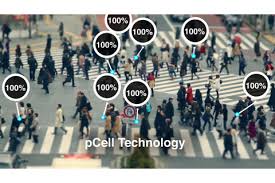aNewDomain.net — As mobile tech continues to dominate, we face a bleak Wi-Fi future of dead zones, video delay, music interruption, personal frustration and lost business deals. Not to fear — the man who brought us QuickTime and WebTV is attacking that dire future.

Credit: Artemis
From his offices at the Rearden Companies, which he founded, Steve Perlman and his team of engineers have been pursuing the dream of a hundreds-of-times faster cell phone and Internet service since the turn of the century. Today, they believe that their system, now embodied as Artemis Networks and comprising “pWaves,” can make mobile device signal connections 1,000 times faster than today’s Wi-Fi, not to mention vastly more reliable. Sounds pretty great, right?
The Tech
The pWaves are the Artemis base stations. In Perlman’s vision these Artemis stations will replace cell towers and, at just the size of an Internet modem, would create pCells (“personal cells”) one centimeter in diameter around every single device connecting to them. Therefore each and every device will receive 100 percent of the signal. No matter how many devices are connecting. You’re reading that correctly.
Check it out:
When Perlman and this team first conceived of Artemis, they were told by everyone in the know that they were nuts. What they wanted to do violated Shannon’s Law which, since 1948, has told us that the maximum rate at which error-free data can be transmitted is a function of the bandwidth and the signal-to-noise ratio. So Perlman hired a researcher to disprove his team’s idea. The researcher failed epically.
Perlman tells us that the trick is to utilize rather than filter out interference:
Instead of dodging interference, pCell exploits interference, combining transmitted radio signals from multiple pCell base stations to synthesize tiny personal cells — pCells — of wireless energy around each mobile device. So rather than hundreds of users taking turns sharing the capacity of one large cell, each user gets an unshared pCell, giving the full wireless capacity to each user at once.”
Today’s cell towers create signal broadcasts that range outward between three and 31 miles. They are also set up to avoid interference. In a world with 4G tech and in which inexpensive, ubiquitous mobile devices are fast coming to dominate bandwidth and signal demand, this setup is doomed to corrosion and ultimate inefficiency. Today’s estimates say that something must be done about it before the year 2020. Or else.

Photo credit: Artemis
The Artemis solution, according to Perlman, is “a radical new approach to wireless that consistently delivers full-speed mobile data to every mobile device concurrently, regardless of how many users are sharing the same spectrum at once. (This will do away with) the congestion, dead zones, and unreliable connections we’ve come to accept with conventional cellular technology.”
Perlman, who owns over 100 patents, has found a startup funding partner who will give him the resources to put Artemis to the test by installing base stations on 350 separate rooftops in San Francisco before the end of 2014. Perlman believes that if the Artemis test runs are successful, then base stations can be deployed in all market-important urban areas of the U.S. by the end of 2015.
Artemis technology will be less expensive, easier to roll out, far-more convenient to place, and faster to deploy than today’s cell tower and Wi-Fi tech. To give you an idea of pWave efficiency: today’s cell towers use 250 milliwats of power — pWaves will use merely one milliwatt each.
Furthermore, mobile devices will save on power because they will not need to try so hard to find and capture a signal. Thus, future mobile devices designed with pCell technology in mind can be lighter, less expensive, and more efficient with their power usage. Perlman goes as far as to say that pCell technology will make 4G grossly inferior and totally replace today’s Wi-Fi.
I don’t know about you, but I’m looking forward to the success of this pCell future. We need it.
For aNewDomain.net, I’m Brant David.
Based in New Jersey, Brant David is a senior writer for aNewDomain.net. Follow him at +Brant David on Google+ and Brant@aNewDomain.net.













I saw the video after MWC and thought about writing a post on it and showing it in my class, but it sounded too good to be true — are there some “hidden gotchas” — some tradeoffs?”
For example, does it scale with things like p-cell density, the number of p-cells per base station, the distance of p-cells from base stations. etc.? Will it work if the clients are moving rapidly — perhaps walking? Driving?
(In the demo he moves the machines slowly, they are very close to the base station and we do not see how many base stations there are or how they are spaced around the room).
Cringely also brings up security worries and bandwidth requirements in this post:
http://www.cringely.com/2014/03/06/pcell-good-linux-runs/?utm_source=rss&utm_medium=rss&utm_campaign=pcell-good-linux-runs
Don’t get me wrong — I hope it works as advertised and am looking forward to the test results from the San Francisco trial.